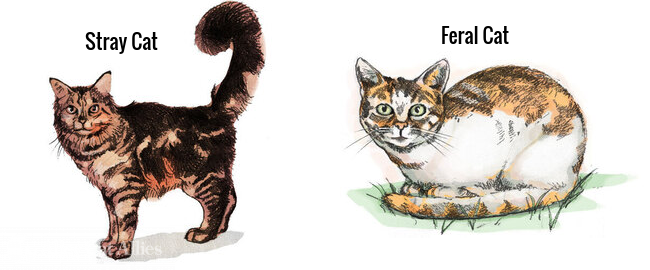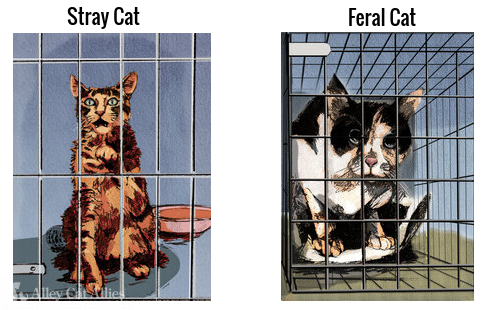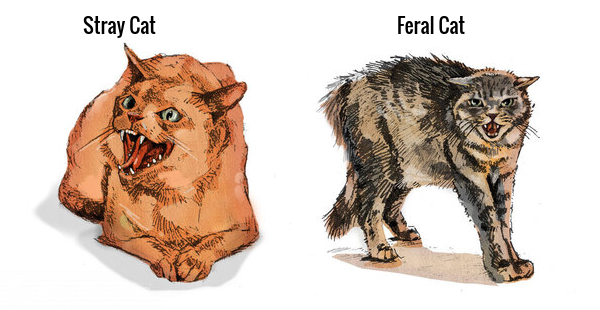Quick Facts:
- “Community cat” is an umbrella term that refers to any member of the Felis catus species who is unowned and lives outdoors. Both feral and stray cats are community cats.
- Community cats have a wide range of behaviors and degrees of socialization. See our comprehensive Cat Socialization Continuum guide.
- Observing a cat’s behavior, including their body language, can help you assess their level of socialization.
- Understanding a cat’s level of socialization can help you act in their best interest.
- Trap-Neuter-Return (TNR) protects and improves the lives of all community cats, regardless of their level of socialization.
Feral, stray, and indoor or pet cats are all members of the same species; they are all domestic cats. However, understanding their behaviors and interactions with people can shed light on the nuances that set them apart. Stray cats and feral cats exhibit distinct characteristics that may not be immediately apparent.
Whether you are a shelter worker, veterinarian, or cat advocate, or you just share your neighborhood with community cats, knowing how to tell the difference can help inform how best to interact with a cat or what, if any, intervention would be in each cat’s best interest.
- What is socialization?
- What is the difference between a stray cat and a feral cat?
- Why does it matter?
- How do I tell the difference when the cats are outdoors?
- How do I tell feral and stray cats apart once I have trapped them?
- What do I do next?
What is socialization?
When we say a cat is “socialized,” we mean she is accustomed to and enjoys companionship with people. To socialize a cat means to acclimate her to human touch, human spaces, and human sights, smells, and sounds. It’s a process that’s influenced by many factors of a cat’s life and takes time and effort from compassionate people.
Kittens become socialized by interacting with people—being held, spoken to, and played with—from an early age. If a kitten does not become accustomed to people holding her and petting her within this crucial window, she will grow up apprehensive of humans and will generally not be suited to or happy living in homes. To ensure a kitten’s well-rounded development, it is essential to integrate socialization activities and exposure to other people and animals into her early socialization process.
What is the difference between a stray cat and a feral cat?
Pet or indoor cats are socialized to people and stray cats have been socialized to people at one point in their lives.
Feral cats are not socialized to people. While they are socialized to their feline family members and bonded to each other, they do not have that same relationship with people.
Community Cats
“Community cat” is an umbrella term that refers to any member of the Felis catus species who is unowned and lives outdoors. Both feral and stray cats are community cats. Community cats have a wide range of behaviors and degrees of socialization, but they generally do not want to live indoors and are unadoptable.
Stray:
- A stray cat is a cat who lived indoors and was socialized to people at some point in her life, but has left or lost her home, or was abandoned, and no longer has regular human contact.
- Over time, a stray cat can become feral as her contact with humans dwindles.
- A stray cat may be socialized enough to allow people to touch her, but she will become less socialized, or even closer to feral, if she spends too much time without positive interaction with humans.
- Under the right circumstances, a stray cat can also become a pet cat once again. Stray cats that are re-introduced to an indoor home after living outdoors may require a period of time to re-acclimate; they may be frightened and wary after spending time outside away from people.
Feral:
- A feral cat is an unsocialized outdoor cat who has either never had any physical contact with humans, or human contact has diminished over enough time that she is no longer accustomed to it. Most feral cats are fearful or people and are not likely to ever become a lap cat or enjoy living indoors.
- Kittens born to feral cats can be socialized at an early age and adopted into indoor homes.
- Alley Cat Allies does not, in general, recommend trying to socialize a feral kitten over 4 months of age. Socializing is time consuming, especially for older kittens, and results are not guaranteed. Learn more about socializing kittens.
Why does it matter?
- Understanding the many degrees of socialization cats can exhibit will help you determine the best way to care for, help, and protect them. See our guide “The Cat Socialization Continuum: A Guide to Interactions Between Cats and Humans” for all the details.
- Stray cats can readjust to living with people and may be good candidates for adoption into indoor homes if people have the time and means to foster and adopt.
- Stray and feral cats can be difficult to tell apart, especially when they are trapped or frightened. Scared stray cats often need time to relax and show their level of socialization.
- Adult feral cats are not socialized to people, which means they cannot be adopted to indoor homes. As a result, they are likely to be killed if picked up by animal control or brought to shelters, so it is in their best interest to continue living outdoors.
- Trap-Neuter-Return saves feral cats’ lives, and benefits all community cats, regardless of their level of socialization. Cats who are part of TNR programs are humanely trapped, scanned for microchips, spayed or neutered, vaccinated, eartipped, and microchipped (if they don’t already have one). Stray cats who are thriving and don’t have microchips indicating they are lost can be returned to their outdoor home or fostered and adopted.
How do I tell the difference when the cats are outdoors?
Since it is difficult to determine each cat’s socialization during a stressful event such as trapping, it’s a good idea to observe cats on their own outdoors using the guidelines below.
NOTE: There is a lot of variation on the Socialization Continuum. Cats may not fit solidly in either socialized-stray or unsocialized-feral categories. Learn more variations possible using our Socialization Continuum guide.
Socialization to Humans
Stray: May approach people, houses, porches, or cars
Feral: Will not approach and will likely seek hiding places to avoid people
Socialization to Other Cats
Stray: Will likely live alone, not part of a group
Feral: May belong to a colony
Body Language
Stray: Might walk and move like a house cat, such as walking with tail up; a sign of friendliness. Will probably look at you, blink, or make eye contact.
Feral: May crawl, crouch, stay low to the ground, and protect body with tail. Unlikely to make eye contact.
Vocalization
Stray: May be vocal, meow, or “answer” your voice
Feral: Won’t meow, beg or purr
Schedule
Stray: Will be visible primarily during the daytime
Feral: More likely to be nocturnal; occasionally out during the day
Physical Appearance
Stray: Will probably be dirty or disheveled; will not have an eartip.
Feral: Will probably have a clean, well-kept coat. A male with a big head and thick neck, muscular body, and/or scars from fighting is more likely to be feral, since these are traits associated with intact males (and only 2% of feral cats are neutered in the U.S.) He may also have a spiky coat from high testosterone levels and less time spent grooming; may also have “stud tail,” hair loss, greasiness, or bumps at the base of the tail due to hormones. Will likely have an eartip if neutered as part of a TNR program.
Pregnancy, Nursing, Kittens
Feral: A female who is pregnant or lactating is more likely to be feral, since fewer feral cats are neutered than pet cats in the U.S.
Remember: A cat’s level of socialization and behavior is not always black and white, particularly for community cats who recognize their caregiver.
They may show signs of familiarity, such as a tail up or hanging out on a caregiver’s porch, but these behaviors are usually limited to the cat’s interaction with the caregiver and only develop after building a relationship over time. It’s important to note that this behavior does not mean that the cat is a good candidate for living indoors.
How do I tell feral and stray cats apart once I have trapped them?
When in a frightening or stressful environment, such as a trap or a shelter, a friendly stray cat may act like a feral cat, avoiding people and possibly even showing aggression to avoid being touched. Who can blame them? The cat is in a new and unfamiliar place.
Here are some ways that will help distinguish a feral cat from a scared stray cat when they are frightened, confined, or in a new place.
Touch Barrier
Stray: It may be possible to touch the cat eventually or she may tolerate a small amount of touching with an object.
Feral: Cannot be touched, even by a caregiver.
Cage Behavior
Stray: May come to the front of the cage. May eventually rub against the cage in a friendly way.
Feral: Will likely stay in the back of the cage and retreat as far back as possible. If jolted or frightened, may shake, rattle, or climb the cage, and could become injured banging into the cage.
Level of Relaxation
Stray: May relax over time.
Feral: Will remain tense and unsocial.
Responsiveness
Stray: May investigate toys or food placed near the cage. May respond to household sounds like cat food cans or bags being opened.
Feral: Will likely ignore all people and toys, and possibly even food. Will not show any familiarity or interest in household sounds.
Fear and Anxiety
Stray: May hiss or growl to show anxiety.
Feral: Will be aggressive and lash out if threatened or cornered (signs of aggression include ears back and eyes dilated).
What do I do next?
Make sure you have all the information needed to make a good evaluation. Once you have evaluated a cat and feel like you have a sense of the cat’s level of socialization, the next step is to get the cat neutered. From there, use your evaluation to do what’s in the cat’s best interest, which may include:
- Returning community cats to their outdoor home
- Maximizing a scared stray’s chances of adoption
- Finding socialized cats a good adoptive home
- Socializing kittens for adoption
Founded in 1990, Alley Cat Allies is the leading advocacy organization for cats with a mission to transform and develop communities to protect and improve the lives of all cats and kittens. Together with our over 1.5 million supporters, we work toward a world where cats are valued and every community has humane and effective programs and policies to defend them.
Through our fearless advocacy, humane care, education and outreach, and law and policy activism, we equip and mobilize citizens, advocates, grassroots groups, shelters, veterinary professionals, and elected officials across the United States and around the world to improve their communities for cats through nonlethal, evidence-based approaches.
Our website is www.alleycat.org, and we are active on Facebook, X (Twitter), Instagram, LinkedIn and YouTube. Charlene Pedrolie is the President and Chief Operating Officer of Alley Cat Allies.




